#umar akmal
Explore tagged Tumblr posts
Text





Umar Akmal batting against Islamabad United
0 notes
Text
'Kohli Wasn't Told 'Your Cricket Is Over...'': Umar Akmal's Emotional Reaction | Cricket
Over the years, the Pakistan cricket setup has seen a number of changes, from a change in the captaincy of the men’s team to the return of Najam Sethi as chairman, with former Pakistan captain Ramiz Raja being unceremoniously sacked last year. . The drafts saw pruning and changes in Pakistan’s squads, with several prominent exclusions from the side; Former skipper Sarfaraz Ahmed not only lost his…
View On WordPress
0 notes
Text

"Mimpi Akmal"
Akmal adalah seorang anak laki-laki berusia 10 tahun yang tinggal di sebuah desa kecil. Akmal sangat menyukai pelajaran agama, dan sejak ia melihat ceramah seorang habib bernama Habib Umar di televisi, ia langsung menjadi penggemar setia. Habib Umar dikenal sebagai ulama yang rendah hati, tutur katanya lembut, dan memiliki ilmu agama yang mendalam. Setiap ceramahnya penuh hikmah dan menginspirasi Akmal untuk menjadi anak yang lebih baik.
"Bu, suatu hari nanti Akmal ingin bertemu Habib Umar," kata Akmal kepada ibunya sambil menatap layar televisi. Ibunya tersenyum. "Kalau Allah mengizinkan, Akmal pasti bisa bertemu dengannya. Tapi ingat, jadilah anak yang baik dulu, ya."
Sejak hari itu, Akmal semakin rajin belajar. Ia selalu mendengarkan ceramah Habib Umar lewat televisi atau YouTube. Bahkan, ia menempelkan foto Habib Umar yang ia cetak dari warnet di dinding kamarnya.
Suatu hari, Akmal mendengar kabar bahwa Habib Umar akan mengunjungi kota terdekat untuk mengisi ceramah akbar di masjid besar. Akmal langsung berlari ke dapur menemui ibunya. "Bu! Habib Umar akan datang ke kota kita! Boleh Akmal pergi ke sana?"
Namun, wajah ibunya terlihat ragu. "Nak, itu di kota. Kita harus naik angkot, dan ongkosnya tidak murah. Lagi pula, ibu harus bekerja di sawah hari itu."
Akmal merasa kecewa. Ia tahu kondisi keluarganya tidak memungkinkan untuk pergi jauh hanya untuk sebuah ceramah, meskipun itu adalah impian terbesarnya. Namun, ia tidak ingin menyerah begitu saja.
Setiap malam, Akmal berdoa, "Ya Allah, jika Engkau mengizinkan, pertemukan aku dengan Habib Umar. Aku ingin sekali mendengar nasihatnya langsung."
Hari ceramah pun tiba. Akmal hanya bisa membayangkan suasana masjid besar yang ramai. Ia duduk di kamarnya sambil menatap foto Habib Umar di dinding. "Mungkin memang bukan rezekiku," gumamnya pelan, menahan rasa sedih.
Namun, di sore harinya, sesuatu yang tak terduga terjadi. Teman ibunya datang ke rumah dan berkata, "Bu, tadi di sawah, saya mendengar ceramah Habib Umar. Subhanallah, suaranya menenangkan sekali."
Mendengar itu, Akmal merasa hatinya semakin sakit. "Kenapa orang lain bisa mendengar ceramahnya, sementara aku tidak?" pikirnya. Ia menutup pintu kamar dan menangis.
Beberapa hari setelah itu, Akmal sedang bermain di depan rumah ketika sebuah mobil melintas di jalan kecil desanya. Mobil itu terlihat berhenti di depan masjid desa, dan beberapa orang turun, termasuk seseorang yang memakai gamis putih dan sorban.
Akmal mengenali wajah itu dari kejauhan. "Itu Habib Umar!" serunya dalam hati. Ia langsung berlari ke arah masjid dengan penuh semangat.
Ternyata, Habib Umar sedang dalam perjalanan pulang dari kota dan memutuskan untuk singgah di desa itu untuk melaksanakan salat. Akmal berdiri di depan masjid, gemetar karena tak percaya. Setelah salat selesai, ia mendekati Habib Umar dengan ragu.
"Habib… saya Akmal," ucapnya pelan sambil menunduk.
Habib Umar tersenyum hangat. "Subhanallah, Akmal. Ada yang bisa saya bantu, Nak?"
Air mata Akmal langsung mengalir. "Habib, saya selalu mendengar ceramah Habib di televisi. Saya ingin sekali bertemu, tapi keluarga saya tidak punya uang untuk pergi ke kota."
Habib Umar menepuk bahu Akmal. "Nak, Allah selalu punya cara untuk mempertemukan hamba-Nya. Karena doa dan usaha kecilmu, Allah membawa saya ke desamu hari ini."
Habib Umar lalu duduk bersama Akmal, berbicara tentang pentingnya berdoa, bersyukur, dan menjaga akhlak. Akmal mendengarkan dengan saksama, merasa seperti berada dalam mimpi.
Setelah pertemuan itu, Akmal semakin semangat dalam belajar agama. Ia tidak hanya mengidolakan Habib Umar, tetapi juga mencoba menerapkan nasihatnya dalam kehidupan sehari-hari.
Dari pengalaman itu, Akmal belajar bahwa mimpi bisa terwujud dengan kesabaran dan doa. Allah selalu memiliki rencana terbaik, bahkan untuk hal-hal yang terlihat tidak mungkin.
2 notes
·
View notes
Photo

Out-of-sort Pakistan batter Umar Akmal flaunted his abs on social media amid criticism of certain players over their poor fitness standards.
0 notes
Text
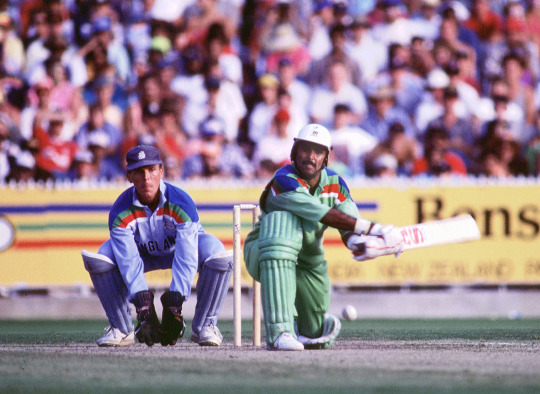
Classic Karachi-Nous: Legend Mohammad Javed Miandad in the 1992 Cricket World Cup Final against England, Melbourne Cricket Ground, Melbourne, Australia. March 25, 1992. Photograph David Munden/© Getty Images
The Jugaaroo! Cheeky, Tough and Masters of Improvisation: How Does Karachi Produce The Batsmen It Does?
Cricketers, like the rest of us, are often perceived to be products of the places they grew up in. Mumbai has a reputation for producing khadoos players, while Hyderabad is popularly regarded as being a nursery for wristy artists, Yorkshire's are dour, while Melbourne's won't give you an inch. Karachi, meanwhile, is said to breed all of these traits into its cricketers: they are inventive, competitive, combative, relishing times when their backs are to the wall, and always looking to grab the game by the scruff of its neck.
— Ahmer Naqvi | Published: June 2, 2016
On March 7, 2015, Pakistan met South Africa in a must-win match at the World Cup. They decided to open with Sarfraz Ahmed. Until then in the tournament, Sarfraz had sat warming the bench - to much criticism - as Pakistan chose to play Umar Akmal as a makeshift wicketkeeper in a bid to bolster the batting. The management had little faith in Sarfraz's batting, especially as an opener, though he had had previous success in the position. Here he was sent to open against the best bowling attack the team had faced so far.
He was beaten inside the line by Dale Steyn the very first ball he faced. "The way I was beaten, it gave me an idea," Sarfraz told me when we met in Karachi a few weeks after the World Cup. "Unless I move forward to meet [the next ball], this gig is going to be up, as the pitch was difficult and the conditions were overcast. So I understood that even if he bowls a sharp bouncer, I could be proactive, as I was ready for him."
Sarfraz started batting out of his crease, shuffling, shifting and sliding effortlessly across it, and eventually scored an entertaining 49. That helped Pakistan to their most authoritative start in the tournament against a major side.
For the casual observer, Sarfraz's daring improv style bore some resemblance to the exciting new strain of batting that livened up the tournament; for this Pakistan side it was an anomaly. Like transistor radios in the age of the internet, this team was composed of batsmen suited to an earlier, forgotten era of cricket. In that light, Sarfraz's innings prolonged the lineage of a distinct strain of Pakistani cricketers.
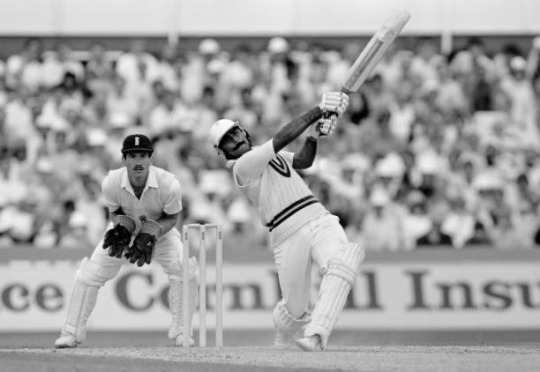
This type of batsman isn't unique to Pakistan, but the Pakistanis who fit it are most likely to be from Karachi. Think of Moin Khan and, to some extent, Rashid Latif. Before them, Asif Mujtaba, and well before them Mushtaq Mohammad and Asif Iqbal, and between them the man who fleshed out the prototype himself, Javed Miandad.
What they had in common was a non-traditional, lateral approach to finding solutions. They looked to generate new ideas. The question was whether this capacity was in some way linked to the city they all hailed from - was there something about growing up in Karachi that conditioned their response? Perhaps this was romanticism - trying to find a reflection of the city I was born in within the game that I loved. But it seemed relevant that when one thought of, for example, the reverse sweep, the advent of proactive running, or counterintuitive strategies, there was always a someone from Karachi involved.
A List of the World's Largest Cities includes several Test centres in the subcontinent. Some, like Lahore and Delhi, are ancient cities with long and grand histories. Some, like Mumbai or Kolkata, are products of colonialism but with a contiguous link to their older pasts.
Cricket's great cities absorb young players and rationalise their approaches. If there is anything unique about Karachi, it is that its tumult has thrown up these players
From having been essentially a fishing village, Karachi was completely transformed by the end of colonialism. So much so that Imran Aslam, a renowned journalist and Karachi resident, says of it: "[It is] a city by the sea [which] has no sea culture, because the entire population here is either Ganga Jamni [from the Gangetic plains of northern India] or from the mountains. You don't get lobsters here, nobody really eats seafood, and you don't see any sailors. It's a city which has no dwellers of its own anymore."
The birth of Pakistan turned Karachi not only into the new capital but also the destination of millions of refugees and migrants, who arrived as much for ideology as for survival. The states of northern India were home to many of the Muslim elites who led the movements for the creation of Pakistan. As such, Karachi was seen as the crystallisation of an idea. The explosiveness of the city's growth soon outstripped the state's ability to realise this idea, and in the decades since, endemic violence has crippled it further.
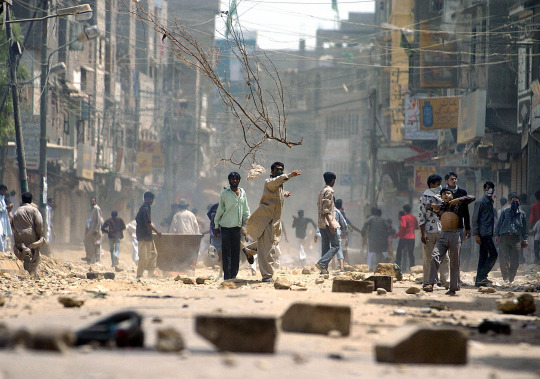
Pakistan's financial hub has withstood decades of civil unrest and tension © Getty Images
Yet it has remained the country's industrial and financial hub as well as its major port. In his book on Karachi, the French author Laurent Gayer describes the city's tense, contradictory equilibrium as an "ordered disorder", and hits at the larger question of Karachi: "How has this city subjected to violent escalation and polarisation… avoided a fully-fledged explosion?" Gayer asks this in the context of the last three decades, when the pervasive levels of violence truly began, but as his book makes clear, the idea of the ordered disorder took root in the city's post-partition development.
Karachi has always been the most consistently tumultuous city in the country. Over time it has given rise to a specific response from its citizens: "rather than coping with crisis," Gayer writes, "they have learned to cope in crisis". Survival instincts are honed that much sharper here.
It manifests itself in a couple of ways. One, as Moin Khan put it to me, is an inner competitiveness. "You are even told at home about the need for healthy competition, and it's very important - if you don't make someone your competitor, then who are you competing with?"
It also brings an urgency and practicality to all tasks, as Rashid Latif illustrated to me through an example of two salesmen. "I take a salesman [outside Karachi] and I tell him, go and do this thing and come back. On his way he will go home and his amma will tell him that she has given the daughter's dupatta to the dyers, so could he please pick it up on his way, but when he gets there the dyer says he'll have it by the evening. So now the salesman figures he is hungry and gets something to eat and it will be evening before he returns to you. In Karachi, you tell him, 'Go do this' and he will go, get it done and come back."
That was not apparent in the cricket immediately. For the first few decades after 1947, Karachi's main source of quality cricketers was its elite, colonial-era schools. They had access to the best facilities and established traditions, and played eagerly contested tournaments. The schoolboy cricketer, particularly one born to Muhajir (or immigrant, to describe those who moved to Pakistan during and after partition) families looking to establish themselves in a new land, was cast with certain expectations and incumbent responsibilities.
Over time Karachi has given rise to a specific response from its citizens: rather than coping with crisis, they have learned to cope in crisis
The consummate product of the school circuit was Hanif Mohammad, and until the 1970s he represented the ultimate ideal of a Karachi batsman. His 337 in Barbados was testament to a young, determined force that refused to give in. Little wonder then that the country, and particularly those sharing his recent migrant past, saw so much of themselves in that effort. It was an innings defined by grit, as the sunburnt layers of skin on his face from 16 hours at the crease testified.
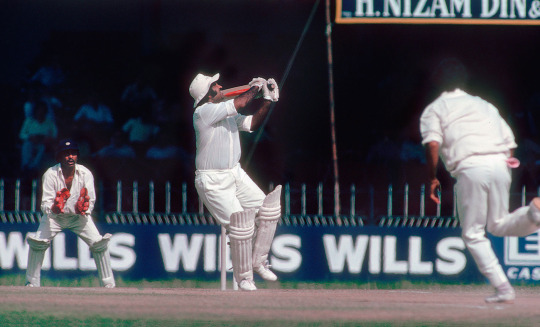
Toughened in Karachi: Mushtaq Mohammad, batting during the 1978-79 Test series against India, was known for his innovative strokeplay and back-to-the-wall performances Patrick Eagar/© Getty Images
However, things would begin to change for both the city and its cricket. Faced with a constantly restive population that defied the state's directives, Ayub Khan, Pakistan's first military dictator, decided in 1960 to move the capital from Karachi. The city continued to attract economic migrants from across the country, becoming simultaneously wealthier but also more unruly. Its centre gyrated to foreign bands and discos and bars, while its peripheries grew rapidly and informally, with the state too overwhelmed to keep up. It was inevitable that cricket would change, and by the '70s the conditions were in place for a new type of batsman to emerge.
Tariq Alam had just completed his matriculation exams in the early '70s when Pakistan's domestic cricket began to induct department sides, such as those of banks, in their first-class set-up. Alam's club had organised a match against a department side where they were set 270-odd to chase and had lost three or four wickets. Keeping with his burgeoning reputation on the local circuit, he walked out and scored a hundred, leading his team to victory. His innings impressed the opponent's sports in-charge, who offered him a spot in the side and a job at the company. Alam was dazed by the offer.
"I was in matric then and I didn't know anything about anything. I just looked at him and said, 'What are you saying?'" he told me in Karachi late last year.
Some seasoned pros urged him to say yes, and Alam headed home to tell his mother and older brother. He remembers being frightened by the turn of events, but his similarly surprised elders quickly realised that he had been offered a job before he had even got to college, and they decided this was the best way forward.
What it meant was that boys from middle-class families could pursue cricket as a serious profession. It meant that playing for clubs could land you a stable job, and in a city driven by the need to survive, it suddenly gave cricket legitimacy in the eyes of a new class of people.
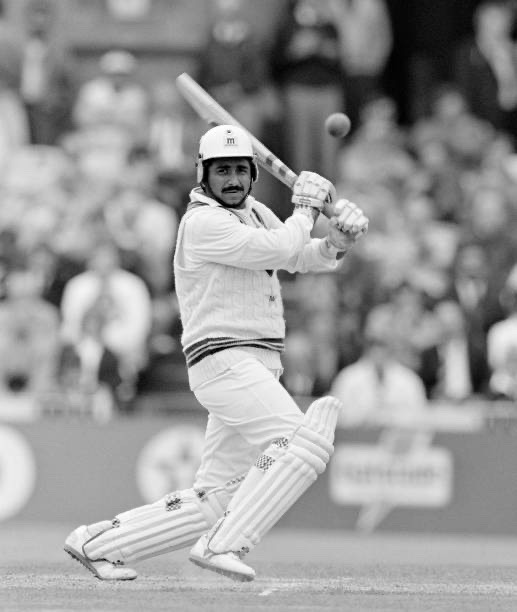
Javed Miandad
While these changes were sweeping through the domestic game, the national team was also changing in decisive ways - both in terms of how it played and how much it was paid. Led by Mushtaq Mohammad, Hanif's younger brother, a new generation of cricketers emerged. They played extensively on the English county circuit, and were attuned to a professional approach to the game and to the competitiveness that came with it. Mushtaq captained a team that provided the template for the modern, unquiet brand of Pakistani cricket - confident, explosive and mercurial.
The apogee of this reinvigoration came, fittingly, in Karachi and against India in 1978. The Indian captain, Bishan Singh Bedi, had already watched Pakistan romp to an improbable win chasing at six an over in the final session of the previous Test, in Lahore. In Karachi the target was stiffer. Pakistan needed 164 to win in 100 minutes, and Bedi was taking few chances, banishing almost his entire field to the boundary. The tactic did not faze Imran Khan, who kept going for, and pulling off, big hits near the end. But what made that chase memorable was how two batsmen chose not to defy Bedi's tactics but to use them against him.
Promoted by Mushtaq, Asif Iqbal and Miandad put on 97 in nine overs, and they did so by tapping the ball instead of blasting it, and running with an aggression unknown to cricket then. Both batsmen were capable of hitting boundaries, but the decision to go for the smarter choice lit up the imaginations of those watching. A small clip online captures their impish assault, in which they pinched doubles and stole byes off dazed fielders. It was, as Zaheer Abbas would later observe, "one-day running but ahead of its time".
Javed Miandad
Miandad's exploits, demeanour and intelligence captured all the qualities that we seemed to identify with the city
But that particular style of batting had already taken root in Karachi's club circuit. Alam, father of Pakistan international Fawad, made quite a name for himself on the club scene - crowds of thousands are said to have flocked to watch club matches in the '70s, and he was often one of the main attractions. An increase in the number of matches exposed players to all sorts of situations, with limited time often requiring a new batting approach.
A certain kind of batsman came to be lionised, one now recognised as a prototype of the ODI finisher. "My batting position, in the middle order, is one where when you arrive at the crease the match situation has become apparent," Alam told me. "From there you have to make sure that you complete your turn at the crease. I only regard someone as a batsman [if he] can take the match with him and return having finished it. If you make 30-40 and get out, then those runs are useless for the team."
The obvious subtext to this approach was a desire for heroism, but one that only took place as a subset of the team's glory - Alam dismissed those batsmen who play for the "Wah wah" of a few dashing strokes. What was crucial was the ability to take the situation by the scruff of the neck and drag the team to its finish. In Urdu, Alam said "match ko pakar ke chalna", or, to grab hold of the game and go along with it. It was an especially resonant phrase.
For example, Moin, whom I met in the sprawling office of his eponymous cricket academy, used a similar phrase to define great batsmen. "Whenever you looked at the great batsmen of the past, it would seem that game ko chala rahe hain khud [they are running the game by themselves], and everything else would be a function of them."

Moin Khan: "You are even told at home about the need for healthy competition - if you don't make someone your competitor, then who are you competing with?" © Getty Images
For modern fans, venerating finishers isn't out of the ordinary. But where nowadays those runs are scored increasingly in boundaries, this type of batsman would use subtler, less bludgeoning methods. Not that there is less risk in this approach. Risk-taking, as Moin explained, is intrinsic to the Karachi approach. "One who doesn't take a risk is caught between two stools. You have to take a risk for your own success. And when you do take a risk, then your approach is always positive."
It is what he did with his running between the wickets, when he felt he had to keep the other team on their toes. "There's a chance in that - sometimes you can make the error, sometimes the fielder will. But until you put pressure on the fielder he won't fumble… and if you're waiting that if he fumbles then only I'll run - no! You have to make him fumble. You know how they say, 'Make it happen'? You have to play with the other's mind."
Jugaar Is A popular Urdu And Hindi Word That Wikipedia Defines As An "Innovative Fix or A Simple Work-Around". A person employing such methods is often referred to as a jugaaroo, which when you think about it really means someone who is good at lateral thinking or at finding solutions that circumvent traditional logic and norms. The rationale behind this piece was that Karachi had a rich tradition of the jugaaroo batsman.
Like transistor radios in the age of the internet, Pakistan's team of 2015 was composed of batsmen suited to an earlier, forgotten era of cricket
The cricketers I spoke to focused very little on the jugaar aspect of batting - they were keen to speak instead about the meaning or purpose of batting rather than the process of it. But the meaning they ascribed to batting also gave away its connection with the approach: they saw themselves as the little guy, the outsider who lacked the privileges that came to others; forever the little guy punching above his weight, goading the opposition and pretending he can bully the bullies, right till he is actually doing so.
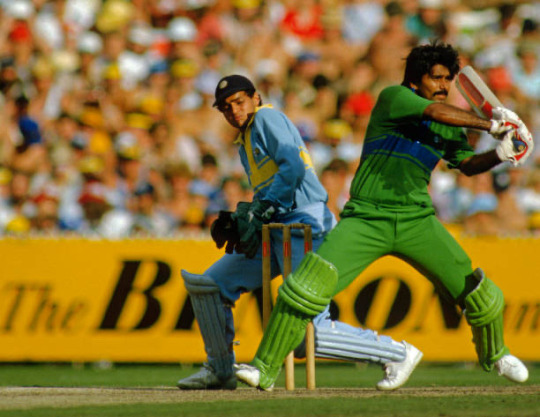
Javed Miandad against India
Imran Aslam had a wonderful quip that perfectly unlocks why the country's largest, richest city would see itself as the little guy or the outsider. Describing the politics - both of cricket and the nation - in Pakistan's two power centres, he says: "When you go to Lahore, they say to you, 'Listen, there's a conspiracy going on against me. You just see, there's a lot of politics going on.' In Karachi, the first conversation is always about injustice."
The word ziyaati - injustice - came up, unprompted, in just about every interview, and it reflects the view that those based in Karachi are outside the system, one that will always seek to attack and marginalise them. The ideal response, then, is to fight back using one's own basic resources, and rely on ideas that exist outside of the norms - in essence, the definition of jugaar.
The longer I spent thinking about this, the more it seemed like Miandad represented the canonical version of the Karachi approach to batting. His exploits, demeanour and intelligence captured all the qualities that we seemed to identify with the city. As Rob Smyth once wrote of him:
"In a sense, all batsmen are doomed. They walk to the crease knowing that their innings is finite, and that it could end at any moment. It takes a very special person to relish that situation, but that's how Javed Miandad played. He had the mentality of a fugitive, content to live on his wits no matter how great the risks. In fact, he needed those risks in order to thrive. The anarchy stimulated him."
(As such, there are certain Karachiites who take a perverse pleasure in riding the city's constant rush of adrenaline. Some friends of mine lived near MA Jinnah Road, one of the city's most symbolic avenues, home to many protests that frequently descend into riots. Describing their hobby as "mob management", they would often look to lead and direct those setting tyres on fire, breaking windows and stoning passing cars. The trick, and the thrill, was to escape before someone realised and the violence was directed at the mob managers.)
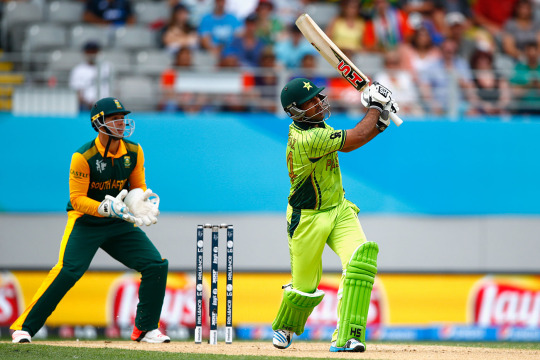
In the modern era, Sarfraz Ahmed's batting has most closely epitomised the Karachi way, as during his 49 against South Africa in Auckland in 2015 © Getty Images
Yet Miandad also transcended this category because he was far too good a batsman, too blessed with skill and ability to be truly considered just a jugaaroo. By design, this approach comes to those who are not as gifted and must find other ways. Think of the innovation that came naturally to Mushtaq, who lacked at least the technique of Hanif. Rather than be daunted, he was creative, experimenting with pinch-hitters like Imran or sending Iqbal to open, and most of all with the reverse sweep, which he lays claim to having invented. That had come in a club game in England in 1964. The problem was Fred Titmus bowling on middle and leg with a midwicket and square leg in place; Mushtaq's solution was to reverse sweep through the vacant point- and third-man region.
Mushtaq had several classic back-to-the-wall performances in his career. A similar sense of crisis inspired Iqbal as well, who was never seen as a top-order batsman and yet was consistently reliable when it was toughest to bat. Osman Samiuddin calculates in The Unquiet Ones that 18 of Iqbal's 23 scores of 50-plus came "with Pakistan in deep strife".
You glimpse it in others from the city too; in Asif Mujtaba's two impossible ODI chases against Australia, sealing a win and a tie with a last-ball six; in Moin's audacious sweeping of Glenn McGrath, a shot he admitted he never dared practise against his own bowlers in the nets; in Sarfraz's heist in Sharjah.
None of this is to claim that such players are unique to Karachi, but it is often true that in a sport as traditionalist as cricket, such players often emerge from the hinterlands, from far-flung areas with self-taught techniques. Cricket's great cities on the other hand soon absorb young players into the sport's institutions, rationalising their approaches. If there is anything unique about Karachi, it is that its tumult and sway have created a propensity for throwing up these players.
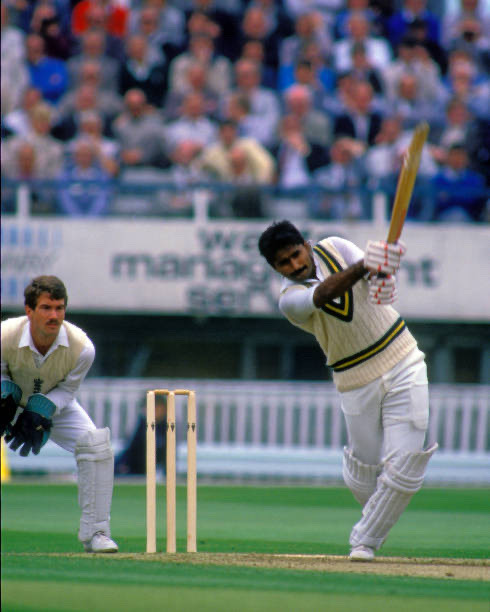
It is difficult to see what the future holds for this sort of player. The opportunities of tape-ball cricket, the city's great love and invention, as well as the techniques it imparts, have affected the ability of local batsmen to adjust to regular hard-ball cricket. One of the links between Rashid's and Moin's era and that of Sarfraz is Shahid Afridi, whose influence on local batting ideals cannot be discounted. More significantly, batting all over the world has undergone a significant evolution, one that Pakistan has missed out on. International cricket is now gone, a further impact on the exposure afforded to local players. Then again, those are exactly the kind of odds against which Karachi batting might thrive.
— Ahmer Naqvi is a Freelance Writer who works for the Music Website Patari. He would like to acknowledge Safieh Shah's help in writing this piece.
— The Cricket Monthly
0 notes
Link
There is hope from the Sharif family after the name of Allah, Umar Akmal Pakistani cricketer U - ...
0 notes
Text
Umar Akmal Was Unable to Pay Daughter’s School Fee During His Ban From Cricket
http://dlvr.it/SvDgCN
0 notes
Link
[ad_1] Pakistan cricketer Umar Akmal gets emotional during an interview. — Screengrab/Youtube/@HadKarDiPakistan batter Umar Akmal became emotional as he spoke about the difficult time he faced during the time he was banned by the Pakistan Cricket Board (PCB) for breaching its anti-corruption code. "No one, not even my enemies, should have to face that the time that I did. Allah tests a person by giving or taking something," said teary-eyed Akmal while speaking during an interview. "However, when I was going through a bad phase, a lot of people revealed their true colours and left my side. But I am thankful to those who still stand beside me," he said.Speaking about the challenges he faced, Akmal said that there was a time when he did not have money to feed his daughter a burger or even pay for her school fees."I could not send my daughter to school for eight months and my wife did not let me down during these tough days," he recalled, saying that he gets tears in his eyes whenever he thinks about those days.Appreciating his wife, Akmal said that he could not thank her enough for supporting him. "My wife was born with a golden spoon but she told me that she will always be supportive of me no matter how bad the situation gets and I am thankful to her for that," he added.The 33-year-old cricketer — who last featured in an international match in 2019 — said that he was trying to make a comeback and will play for Pakistan once again with his hard work.Akmal was suspended by the PCB in 2020 for violating the anti-corruption rules. He was banned for three years, however, he filed an appeal to the International Court of Arbitration after which his sentence was reduced to 12 months. [ad_2]
0 notes
Link
Pakistanlı kriket oyuncusu Umar Akmal röportaj esnasında duygulanıyor. — Screengrab/Youtube/@HadKarDiPakistan'ı vuran Umar Akmal, yolsuzlukla savaşım yasasını ihlal etmiş olduğu için Pakistan Kriket Kurulu (PCB) tarafınca yasaklandığı sırada karşılaşmış olduğu zor dönemden bahsederken duygusallaştı. Bir röportaj esnasında gözleri yaşlı Akmal, "Benim yaşadığım durumla asla kimse, hatta düşmanlarım bile yüzleşmek zorunda kalmasın. Tanrı insanı bir şey vererek yada alarak sınav eder" dedi. "Sadece fena bir dönemden geçtiğimde birçok insan gerçek yüzünü ortaya çıkardı ve yanımdan ayrıldı. Fakat hâlâ yanımda duranlara minnettarım" dedi.Karşılaşmış olduğu zorluklardan bahseden Akmal, bir dönem kızına hamburger yedirecek, hatta okul harcamalarını bile karşılayacak parasının olmadığını söylemiş oldu."Kızımı 8 ay süresince okula gönderemedim ve bu zor günlerde eşim beni yarı yolda bırakmadı" diye hatırlatarak, o günleri düşündükçe gözlerinin yaşardığını söylemiş oldu.Eşine teşekkür eden Akmal, kendisine destek olduğundan kendisine yeterince teşekkür edemediğini söylemiş oldu. "Eşim altın kaşıkla doğmuştu fakat durum ne kadar fena olursa olsun bana devamlı destek olacağını ve bunun için kendisine müteşekkir olduğumu söylemiş oldu."Son olarak 2019'da internasyonal bir maçta forma giyen 33 yaşındaki kriket oyuncusu, geri dönüş hayata geçirmeye çalıştığını ve sıkı çalışmasıyla bir kez daha Pakistan adına oynayacağını söylemiş oldu.Akmal, yolsuzlukla savaşım kurallarını ihlal etmiş olduğu nedeni öne sürülerek 2020 senesinde PCB tarafınca açığa alındı. Üç yıl uzaklaştırma cezası aldı sadece Internasyonal Tahkim Mahkemesi'ne itirazda bulunmuş oldu ve peşinden cezası 12 aya indirildi.
0 notes
Text
"Wasted Talent": Ramiz Raja Gives Brutal Assessment Of Pakistani Batter
Former Pakistan cricketer Ramiz Raja© Twitter Former Pakistan Cricket Board (PCB) Chief Ramiz Raja showered praises on veteran Pakistan batter Umar Akmal for his explosive innings for Quetta Gladiators in the Pakistan Super League (PSL) encounter against Islamabad United but also ended up calling him a “wasted talent”. Akmal was in tremendous form as he scored 43 runs off just 14 deliveries and…

View On WordPress
0 notes
Text
Le Pakistan a interdit mardi le joueur polyvalent Asif Afridi de tout cricket pour une période de deux ans après avoir plaidé coupable à deux violations du code anti-corruption du conseil. "Afridi s'est vu infliger une période d'inéligibilité de deux ans, tandis qu'il s'est vu infliger une interdiction de six mois pour violation d'une deuxième clause", a déclaré le Pakistan Cricket Board dans un communiqué. Afridi a été initialement suspendu en septembre de l'année dernière pour avoir omis de signaler une approche "pour se livrer à une conduite corrompue" lors du tournoi National Twenty20. Lors de l'annonce de la décision, le PCB a déclaré qu'il avait examiné la demande d'Afridi d'examiner son cas avec compassion. Il a affirmé qu'il avait involontairement enfreint le code. Le joueur de 36 ans faisait partie d'une équipe pour affronter l'Australie lors de matches à durée limitée l'année dernière, mais n'a joué dans aucun d'entre eux. Le cricket pakistanais a une histoire d'interdictions de matchs truqués, avec une enquête judiciaire interdisant l'ancien skipper Salim Malik et le couturier Ata-ur-Rehman à vie et infligeant une amende à six meilleurs joueurs de cricket - dont Wasim Akram et Waqar Younis - en 2000. Salman Butt, qui était alors le skipper de l'équipe, Mohammad Amir et Mohammad Asif ont été bannis pendant cinq ans dans une affaire de spot-fixing en Angleterre en 2010. Deux ans plus tard, le danois Kaneria, qui fait tourner les jambes, a été banni à vie pour une affaire de spot-fixing dans le cricket anglais. Dans un passé plus récent, Umar Akmal, Sharjeel Khan, Khalid Latif, Shahzaib Hasan, Mohammad Nawaz et Mohammad Irfan ont également été interdits dans diverses affaires de spot-fixing.(Cette histoire n'a pas été éditée par le personnel de NDTV et est générée automatiquement à partir d'un flux syndiqué.)
0 notes
Text
Umar Akmal's Emotional Reaction on Why He Shouldn’t Play Cricket

There are a lot of changes that happened in the last few years in the Pakistan cricket team. Najam Sethi, who is the chairman of the Pakistan Cricket Board, has also made his way back to the management. The last captain Sarfaraz Ahmed had not only lost his captaincy but was also struggling for a chance to play for the Pakistan cricket team in Test XI. Last month, he made his comeback to the team in a match against New Zealand. Read more...
0 notes
Text



Exhibition match to be played in Quetta 🇵🇰
In build-up to the upcoming eighth edition of the PSL, the PCB, in collaboration with the Balochistan government, is set to host an exhibition match at Quetta's Bugti Stadium
2019 champions Quetta Gladiators and 2017 champions Peshawar Zalmi will face each other in an exhibition match on February 5 in Quetta
Sarfaraz Ahmed will lead team purple and Babar Azam will be the captain of team yellow. Babar will be joined by star cricketers including Shahid Afridi, Wahab Riaz, Mohammad Haris, Danish Aziz and Saim Ayub in his team
Sarfaraz's team purple will feature Iftikhar Ahmed, Mohammad Hasnain, Naseem Shah, and Umar Akmal
February 5th is also Kashmir Day 🤍
0 notes
Text
1 note
·
View note
Link
There is hope from the Sharif family after the name of Allah, Umar Akmal - https://abcexpress.pk/there-is-hope-from-the-sharif-family-after-the-name-of-allah-umar-akmal.php...
0 notes